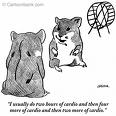Body Recomposition or Body Decomposition?
/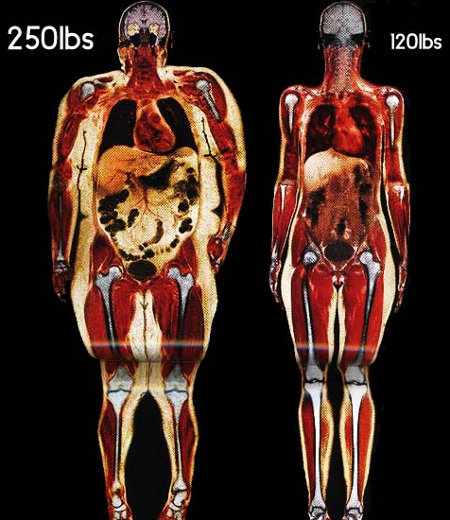 All too often, clients obsess over body weight, weighing themselves daily on overpriced, deceptively marketed, home scales. While weight loss may be a good measure of assessment for obese individuals, goals change as one reaches a healthy weight. Body composition, a comparison of ones lean to fat mass, is a better reflection of health. While an obese individual's goal is to lose as much mass as possible, this loss of mass is also at the expense of lean tissues, such as muscle and bone. Once a desired weight, or Body Mass Index, is achieved, its important to reevaluate goals, programming, and diet, shifting the focus to building lean mass, and continuing to burn unwanted body fat. What may have worked to drop a significant amount of pounds, is not going to work for cutting fat and building muscle. Muscle is developed through appropriate doses of resistance training, followed by a proper balance of macronutrients and sleep. Muscle is metabolically active tissue. It requires a lot of calories to develop and a lot to sustain. This increased energy demand to sustain your newly developed muscle mass, taps into fat stores, and devotes consumed calories toward the creation and sustenance of your metabolically active tissues, thereby stripping you of excess body fat. This is a delicate balance, however. Too many calories, and your body will store the excess as fat; to few calories, and your body will shed muscle, conserving calories for vital organ function, thereby decreasing your metabolism. (see Resting Metabolic Rate) To determine your resting metabolic rate, use this formula, or consult with a local dietician to help establish an eating plan that maximizes lean mass development, increases your metabolism, and burns fat! Seek out a fitness professional in your area, and have your body fat measured. Read these steps The Hierarchy of Fatloss, outlined by famed fat loss guru Alwyn Cosgrove, on the most effective activities for developing muscle and burning fat. Hint: Its not cardio!!!!!!!!!!
All too often, clients obsess over body weight, weighing themselves daily on overpriced, deceptively marketed, home scales. While weight loss may be a good measure of assessment for obese individuals, goals change as one reaches a healthy weight. Body composition, a comparison of ones lean to fat mass, is a better reflection of health. While an obese individual's goal is to lose as much mass as possible, this loss of mass is also at the expense of lean tissues, such as muscle and bone. Once a desired weight, or Body Mass Index, is achieved, its important to reevaluate goals, programming, and diet, shifting the focus to building lean mass, and continuing to burn unwanted body fat. What may have worked to drop a significant amount of pounds, is not going to work for cutting fat and building muscle. Muscle is developed through appropriate doses of resistance training, followed by a proper balance of macronutrients and sleep. Muscle is metabolically active tissue. It requires a lot of calories to develop and a lot to sustain. This increased energy demand to sustain your newly developed muscle mass, taps into fat stores, and devotes consumed calories toward the creation and sustenance of your metabolically active tissues, thereby stripping you of excess body fat. This is a delicate balance, however. Too many calories, and your body will store the excess as fat; to few calories, and your body will shed muscle, conserving calories for vital organ function, thereby decreasing your metabolism. (see Resting Metabolic Rate) To determine your resting metabolic rate, use this formula, or consult with a local dietician to help establish an eating plan that maximizes lean mass development, increases your metabolism, and burns fat! Seek out a fitness professional in your area, and have your body fat measured. Read these steps The Hierarchy of Fatloss, outlined by famed fat loss guru Alwyn Cosgrove, on the most effective activities for developing muscle and burning fat. Hint: Its not cardio!!!!!!!!!!
Soft Body Pilates
/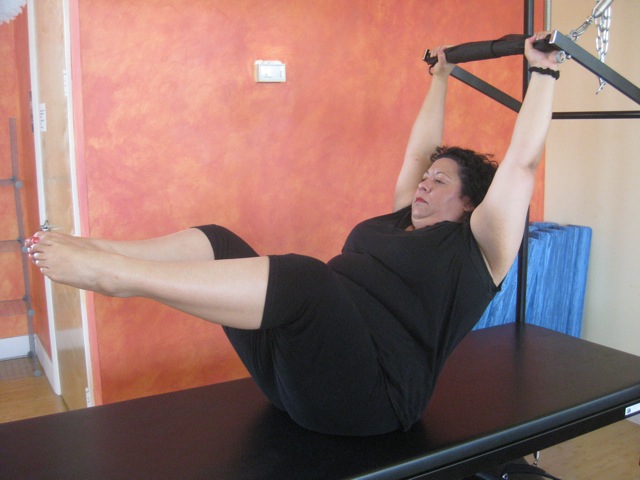 Pilates is great for creating mind/body awareness, skilled movement, and physical introspection that we do not always spend time with on the gym floor. It is sometime defined as controlled movements through a strong core. Id like to think all training could be described this way. The "long, lean look" they preach is more of a selling point. Long lean muscles are created in the kitchen with your diet, and your genetics. Though I know what everyone means, when they say they want to get "toned," its actually a reflection of the tension or strength your muscles can create. Strength and tension is created using resistances of progressive intensity. Being defined, is a reflection of your body composition, which is 80% diet, some training, and genetics. Using "smaller muscles" is not entirely true either. Muscles used for movement can be categorized as agonists, antagonists, stabilizers, and neutralizers. They are all involved in any body movement, from getting out of a chair, to walking, movements on a Pilates reformer, or bench pressing in the gym. Agonists and antagonists are your main movers, the pushers and pullers, flexors and extensors. They re the muscles you see and become developed, hence their focus in exercise. You also have muscles that aid these movements called stabilizers and neutralizers. Theses muscles stabilize joints throughout your agonist movements and neutralize any unwanted movement elsewhere in the body when performing an exercise. These muscles are often under your superficial muscles, making them harder to visualize. They are also not as voluntary, making it harder for you to recruit and engage, sometimes even involuntary, and do not need to be engaged, i.e. the transverse abdominus. This lack of awareness or ability to engage or recruit has made Pilates and mind/body training popular. However, in Pilates, like any other mode of exercise, all four types of muscle actions are taking place, and no single mode of exercise truly isolates any of these. So to say Pilates works small muscles is not entirely true. In fact, I would argue that the resistance generated during a barbell squat or dead lift recruits more of your smaller stabilizing/neutralizing muscles, than a resistance created on the reformer with resistant springs attached, much like a bench press or pull up, trains the smaller muscles more than pulls on the cadillac, or equivalent pushing movement in Pilates. It does have application for corrective exercise and injury prevention/rehabilitation in addition to traditional resistance training. However, it lacks progressions, scientific periodization, and objective measures of its training protocols. If you continued to use the same resistance for a given exercise, you would plateau and eventually regress, as that stimulus would no longer elicit a response. There s a diminishing return for the same intensity, which is why strength and conditioning applies systematic progressions.
Pilates is great for creating mind/body awareness, skilled movement, and physical introspection that we do not always spend time with on the gym floor. It is sometime defined as controlled movements through a strong core. Id like to think all training could be described this way. The "long, lean look" they preach is more of a selling point. Long lean muscles are created in the kitchen with your diet, and your genetics. Though I know what everyone means, when they say they want to get "toned," its actually a reflection of the tension or strength your muscles can create. Strength and tension is created using resistances of progressive intensity. Being defined, is a reflection of your body composition, which is 80% diet, some training, and genetics. Using "smaller muscles" is not entirely true either. Muscles used for movement can be categorized as agonists, antagonists, stabilizers, and neutralizers. They are all involved in any body movement, from getting out of a chair, to walking, movements on a Pilates reformer, or bench pressing in the gym. Agonists and antagonists are your main movers, the pushers and pullers, flexors and extensors. They re the muscles you see and become developed, hence their focus in exercise. You also have muscles that aid these movements called stabilizers and neutralizers. Theses muscles stabilize joints throughout your agonist movements and neutralize any unwanted movement elsewhere in the body when performing an exercise. These muscles are often under your superficial muscles, making them harder to visualize. They are also not as voluntary, making it harder for you to recruit and engage, sometimes even involuntary, and do not need to be engaged, i.e. the transverse abdominus. This lack of awareness or ability to engage or recruit has made Pilates and mind/body training popular. However, in Pilates, like any other mode of exercise, all four types of muscle actions are taking place, and no single mode of exercise truly isolates any of these. So to say Pilates works small muscles is not entirely true. In fact, I would argue that the resistance generated during a barbell squat or dead lift recruits more of your smaller stabilizing/neutralizing muscles, than a resistance created on the reformer with resistant springs attached, much like a bench press or pull up, trains the smaller muscles more than pulls on the cadillac, or equivalent pushing movement in Pilates. It does have application for corrective exercise and injury prevention/rehabilitation in addition to traditional resistance training. However, it lacks progressions, scientific periodization, and objective measures of its training protocols. If you continued to use the same resistance for a given exercise, you would plateau and eventually regress, as that stimulus would no longer elicit a response. There s a diminishing return for the same intensity, which is why strength and conditioning applies systematic progressions.
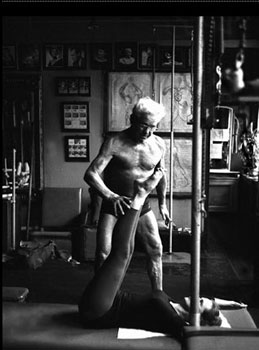
Often yogis, dancers, and individuals that are already genetically lean, long, and flexible, are drawn to Pilates, which allowed for a subcultural attractive look to develop. You don't see overweight Pilates clients, because they are doing something more efficient for fat loss, and an overweight Pilates instructor can not stay in business long. It would be fair to say that many personal trainers are former athletes or fitness enthusiasts that always had good genetics and results too, but there are many trainers with life transforming stories. Because Pilates is fairly new and does not have mass appeal yet, there is little science or research to support any of its benefits. The entire philosophy of Pilates was developed by one German man looking for an alternative way to be healthy through physical activity. It is now passed on from instructor to instructor and has evolved over time. Many fitness professionals, on the other hand, have degrees in exercise science and internationally recognized certifications. Their training and expertise is routed in science, supported by facts and centuries of historical application. I recently had a conversation with a Pilates instructor who mentioned their instruction specifically avoids anatomical terminology, in terms of their branding and imaging. And while some instructors are educated in anatomy and physiology, the focus of Pilates is more about feeling and less about applying real theory. In some ways it made me think of a placebo....
5 Components of Health Related Physical Fitness
/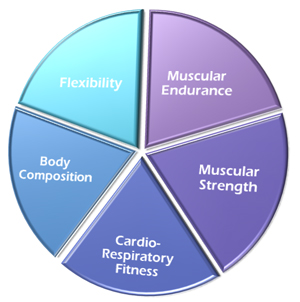
Did you know there are 5 key components of health related physical fitness? Do you know what they are? How do you stack up within all 5? Many of us over develop one area, neglecting others. Here they are listed in order of my opinion of importance.
Body Composition  - What percentage of fat mass is your body relative to your lean mass? Click on this link for a simple tool to gage how health your current body comp is. Human beings are fatter than ever before in the history of man. It is estimated that over 60% of Americans are overweight and or obese. Science has pinpointed a slew of chronic to lethal health problems associated with being overweight. Overweight being defined as having a Body Mass Index (BMI) of over 24. Click here to get yours now. However, this does not take into consideration the density of lean mass. Many athletes and exercise enthusiasts may be deemed over weight according to their BMI. A better yardstick would be calculating your body composition. Click on this link to gage where you are at or seek out your local personal trainer to conduct a body fat analysis.
- What percentage of fat mass is your body relative to your lean mass? Click on this link for a simple tool to gage how health your current body comp is. Human beings are fatter than ever before in the history of man. It is estimated that over 60% of Americans are overweight and or obese. Science has pinpointed a slew of chronic to lethal health problems associated with being overweight. Overweight being defined as having a Body Mass Index (BMI) of over 24. Click here to get yours now. However, this does not take into consideration the density of lean mass. Many athletes and exercise enthusiasts may be deemed over weight according to their BMI. A better yardstick would be calculating your body composition. Click on this link to gage where you are at or seek out your local personal trainer to conduct a body fat analysis.
Muscular Strength  - The ability to produce force. More importantly work = force x distance. If you cannot apply a given force, you may not even be able to move in extreme circumstances. In order to apply force and move, you need muscle mass. Your body develops that mass through resistance activities. Very important concepts to grasp as you age, your muscle mass decreases, which may one day limit your ability to get out of a chair! And back to body composition, the more lean mass you have (muscle), the less fat mass you should have in theory. So why not kill two birds with one stone, but developing your strength and body composition at once with some resistance activities you enjoy.
- The ability to produce force. More importantly work = force x distance. If you cannot apply a given force, you may not even be able to move in extreme circumstances. In order to apply force and move, you need muscle mass. Your body develops that mass through resistance activities. Very important concepts to grasp as you age, your muscle mass decreases, which may one day limit your ability to get out of a chair! And back to body composition, the more lean mass you have (muscle), the less fat mass you should have in theory. So why not kill two birds with one stone, but developing your strength and body composition at once with some resistance activities you enjoy.
Muscular Endurance  - Your body's ability to apply force repeatedly for a prolonged amount of time. Forget about getting out of your chair, can you do that repeatedly throughout the day, climb a flight of stairs, or walk for an extended period of time? Muscular endurance is very important for activities you would like to do beyond brief bursts of energy. If you want to stay active, maintain your muscular endurance.
- Your body's ability to apply force repeatedly for a prolonged amount of time. Forget about getting out of your chair, can you do that repeatedly throughout the day, climb a flight of stairs, or walk for an extended period of time? Muscular endurance is very important for activities you would like to do beyond brief bursts of energy. If you want to stay active, maintain your muscular endurance.
Cardiovascular Endurance  - Your heart and lung's ability to delivery oxygen and nutrient rich blood to your working muscles for muscular strength and endurance (anaerobic (without oxygen) activity) and cardio (aerobic (with oxygen) activity). If the heart and lungs are working optimally, forget about everything above. But dont spend too much time doing cardio. The American Heart Association recommends 30 cumulative minutes or more per day of aerobic activity to sustain sufficient heart and lung capacities. 60 min or more per day to manage weight! That 60 min would be better spent with 3-4 days of resistance training to develop your lean mass, shed fat mass, and boost your resting metabolism with metabolically active muscle!
- Your heart and lung's ability to delivery oxygen and nutrient rich blood to your working muscles for muscular strength and endurance (anaerobic (without oxygen) activity) and cardio (aerobic (with oxygen) activity). If the heart and lungs are working optimally, forget about everything above. But dont spend too much time doing cardio. The American Heart Association recommends 30 cumulative minutes or more per day of aerobic activity to sustain sufficient heart and lung capacities. 60 min or more per day to manage weight! That 60 min would be better spent with 3-4 days of resistance training to develop your lean mass, shed fat mass, and boost your resting metabolism with metabolically active muscle!
Flexibility  - last but certainly not least, and arguably of greater hierarchy than my list here. Really, the ability to move at all. The elasticity of your soft tissue, ie, muscles, tendons, and ligaments. A tight muscle muscle is second only to a weak muscle. A tight muscle is unable to apply a force across its entire surface area, through a full range of motion(ROM). While there are perils to being hyper-flexible, on the scheme of things, most people never get close to that. Though your joints require some degree of stability, many of us have less than optimal ROM around these joints. More often than not chronic pain or injury can be relieved through regular flexibility and muscular development training.
- last but certainly not least, and arguably of greater hierarchy than my list here. Really, the ability to move at all. The elasticity of your soft tissue, ie, muscles, tendons, and ligaments. A tight muscle muscle is second only to a weak muscle. A tight muscle is unable to apply a force across its entire surface area, through a full range of motion(ROM). While there are perils to being hyper-flexible, on the scheme of things, most people never get close to that. Though your joints require some degree of stability, many of us have less than optimal ROM around these joints. More often than not chronic pain or injury can be relieved through regular flexibility and muscular development training.
So what areas have you been neglecting? Perhaps its time to back off on the cardio or strength training or give some of these other important aspects some work. Cross training is a great way to stimulate the body, allow it to recover, and avoid injury, Ideally, all 5 of these components should be apart of your regular fitness regimen.
Macronutrients and Eating a Balanced Diet - Fat Phobia
/As Americans continue to struggle with diet and obesity, we keep looking for things to eliminate from out diets as the next hot weight loss trend. First it was fat, fat free everything, which led to over consuming over processed carbohydrates, and a heavier population. Why are we so fat phobic? Dietary fat, should have a different name. Though its chemically similar to the adipose tissue we store in our bodies, and every cell is made of, including 2/3 of our brains, consuming dietary fat does not necessarily lead to storing more adipose tissue. Yes, dietary fat is calorically dense, so it should be eaten in moderation. That density though, packs a punch in terms of satiety. Fat slows down digestion, which slows down the rate at which you blood is flooded with the sugar from the carbs you are also eating. Foods, specifically carbohydrates are ranked according to their glycemic index, a scale measuring the level of blood glucose and insulin levels after eating. Low glycemic foods are the secret to long-term health, reducing your risk of heart disease and diabetes, and is the key to sustainable weight loss. Fat slows theses foods absorption rate, thereby lowering the natural glycemic index. Additionally, fat triggers hormones in the body that leave you more satisfied sooner, and longer. Healthy fats include mono and poly unsaturated fats, high in omega 3 and 6 fatty acids which have been proven to boost and protect brain and heart function. Foods rich in these fats, include olive,nut and seed oils, avocados, nuts and seeds, fish, and some plants. Additionally, some grass fed animal proteins and dairy now contain high levels of omega 3 and 6. Start incorporating healthy fats into your balanced diet of lean proteins, plant-based complete protein combinations and high fiber, low glycemic carbohydrates. These 3 macronutrients should be consumed at every meal and snack to control hunger, blood sugar, weight management, and physical and mental performance.
Look out for my next blog on macronutrients as I explore the mistakes and benefits of protein and carbohydrate consumption as part of a balanced diet.
Tapping into Muscle Mass - Type I and II Muscle Fibers
/Many people make the mistake of only ever training one muscle fiber type. We are all born with different proportions of 3 muscle fiber types, which give us all different body shapes and abilities, notably important in athletics and whether your body is geared more towards endurance or power activities. For the exercise enthusiast and health conscious. Training the full spectrum of your muscle mass is important to developing your lean mass and warding off fat mass. Type 1 fibers are also referred to as slow twitch muscles. They have a high oxygen carrying capacity, which aids slow sustained contractions of moderate output, endurance. Training these fibers includes endurance activities such as steady state cardio, and resistance training programs above 20 repetitions at a lower weight and speed.
Type 2 fibers, also known as fast twitch, allow rapid contractions of high intensity for a short amount of time, power. Activities include explosive movements, such as strength and power lifting with repetitions below 6, anaerobic activities like sprinting, jumping, etc for intervals less than 60 seconds or so. These fibers have been categorized further into type 2a and type 2b, but we will not get into that in this blog.
Suffice to say we are all built to have a greater proportion of one fiber type than the other. Allowing us to be better at certain activities than others, with some over lap. For the average exerciser, its important to train and develop both of these fiber types to stimulate the full spectrum of your lean mass. The goal being to develop lean mass to increase metabolism, resting energy expenditure, burn more fat, and store less. Most of us today would like a lean athletic physique. However, alot of exercisers either do excessive amounts of muscle wasting cardio, which I discussed in my Cardio vs. Resistance Training blog, or they do too many repetitions of less than stimulating resistances. Nobody wants to "bulk up" these days. Bulking up, requires high calorie consumption, good genes, and great training. Conventional wisdom however, training light resistances to achieve slim lean looks, is not supported by science. High reps, low weight does not mean high reps, no weight. You need to stimulate your type one and two fibers by attacking their specific energy system. To do this, type 1 fibers need to be trained to fatigue with repetitions schemes of 15-25 repetitions or 20-60 seconds. Type 2 fibers should be trained at high loads appropriate to reach failure within 6 or less repetitions or 20 or less seconds. Stimulating both fibers and training within both energy systems is more stimulating to your body and your mind. For better muscle tone trying adding more resistance and fewer reps to your routine.
Cardio vs Resistance Training for Fat Loss
/Theres a common misconception that cardio is a more effective fat loss tool than resistance training. This could not be further from the truth. The jogging boom of the 80s and a misinformed media would lead you to believe you need to work your "fat burning zone" to lose fat. Not to mention when you walk into your local health club there are more cardio machines than free weights. Unfortunately, those machines are there because that is what you are looking for when you buy your membership. Next time you are doing cardio, take a break from the magazine or television program you are viewing and look at the gym floor. Who looks better, the people doing cardio, or the people doing resistance exercises? I know that's a very anecdotal example, so let me elaborate with science based facts.
The hierarchy of fat loss is DIET, resistance training, high intensity interval training, and then cardio. All the training in the world will not get you to your goals if you don't have a sound diet. But lets talk about resistance training. Science has proven a significant metabolic increase for up to 48 hours after resistance workouts. Conversely, typical steady state cardio routines show no post workout energy consumption. Once you step off that treadmill, the caloric burn stops, and while you are on the treadmill you could be eating your metabolically active muscle tissue and decreasing your metabolism. After a resistance workout, your body works to repair the muscle tissue your broke down, burns calories to build it up, and requires even more calories to sustain your new lean mass! You have just increased your metabolism and are burning calories while you are at rest. So get your diet in check, add three full body resistance routines to your week and forget about cardio.
Check out my blog on Compound, Multi-muscle Calorie Burners and Tapping into Your Muscle Mass for more info on full body resistance training information. Alywn Cosgrove, THE fatloss guru, recently wrote a great follow up post to the Men's Health post The New Science of Fatloss on the myths of cardio training, how they originated, and why they are perpetuated. Check it out!


